
Newsletter of the Shell Club of Sydney
NSW Branch, The Malacological Society of Australasia Limited ACN 067 894 848
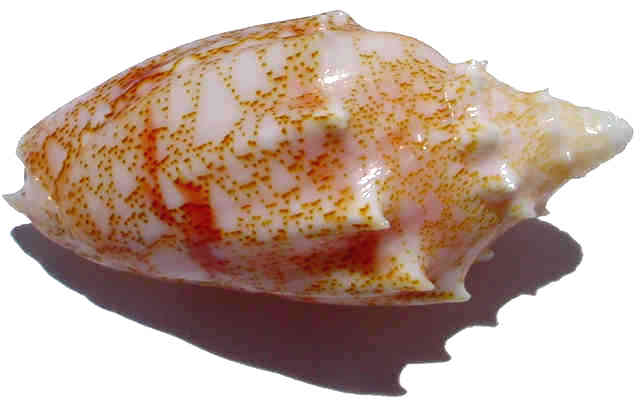
Cymbiolacca excelsior, Swains Reefs, GBR, QLD. Size 58.7 mm
Courtesy Steve Dean
Shells to Swap:
If you have spare shells and would like to find someone to swap with, try listing some of them here:
Alison Haynes From the Institute of Applied Sciences, University of the South Pacific in Fiji has written a book titled "Freshwater Snails of the Tropical Pacific Islands" 116 pages, full colour, semi-hardcover. Cost for direct purchase from the writer is US$15 + $4 pp
She has sent us an order form that I will bring to club rather than copying here.
The book is intended for academics, students, freshwater ecologists, libraries, museums and interested general readers. It is the first book on the subject in colour. As it was released in June this year, I assume it is the one Paddy has on sale. It covers islands between and including the Cook Islands, Hawaii, Guam, Solomons, Vanuatu, New Caledonia, and Fiji
A Haynes, IAS, USP P.O. Box 1168, Suva Fiji (679) 320397
GOLD COAST OBSERVATIONS
By John Franklin
Taking advantage of our holiday location at Broadbeach Queensland it was decided to do a beach/rock hop along the coastline commencing from the Spit just north of Southport down to Kingscliff in New South Wales. We commenced our journey on the 8th October 2001 and over the ensuing week, travelling by car, we stopped at each beach and in particular examined the rocky outcrop at the headland point.
It was found that only the exposed southern side of Burleigh Heads reflected some degree of shell life in the area.
The observations were confined only to Gastropods and Bivalves.
CLASS GASTROPODA
Patellida Cellana Framoserica
Neritidae Nerita Polita Linn
Neritidae Albicilla Linn 1758
Neritidae Atramentosa Reeve 1855
Trochidae Austrocochlea Concamerata Wood
Littorinidae Bembicium Nanum (Lamarck 1822)
Cypraeidae Cypraea Arabica Linnaeus 1758
Muricidae Cronia Aurantiaca (Hombron & Jacquinot 1853)
Muricidae Morula Marginalba Blainville, 1832
Muricidae Lepsiella Vinosa (Lamarck, 1822)
Volutidae Amoria Zebra (Leach, 1814)
Siphonariidae Siphonaria Denticulata Quoy & Gaimard, 1833
CLASS BIVALVIA
Pteriidae Electroma Georgiana (Quoy & Gaimard, 1835)
Donacidae Donax Deltoides Lamarck, 1818
It was noted that the entire coastal strip comprised long sandy beaches with hilly rocky outcrops projecting into the sea. Even at low tide few rock platforms were revealed. As a consequence there appeared to be a marked absence of cunjevoi, rock-barnacles, tube worms, periwinkles and other marine life.
This fact is in contrast to the comparative abundance of marine life in the Sydney region.
The Haliotidae of New South Wales.
By Ashley Miskelly.
There are four species of Haliotis occurring in New South Wales. They are as follows:
Haliotis rubra Leach, 1814
Haliotis coccoradiata Reeve, 1846
Haliotis brazieri, Angas, 1869
Haliotis hargravesi, Cox, 1869
H.rubra is the largest and most common abalone species and it grows to a length of 160mm. It is commercially consumed for food. The shell has about 8 open holes and many closed holes. A well cleaned shell is pinkish brown in colour, with many fine concentric ridges. The specimen of
H.rubra shown to the right was dead collected at low tide on rocky reef at Shark Island, Sydney Harbour, but live specimens have been seen at Vaucluse Bay. The specimen measures 140mm across.
H.rubra is a common species just below low tide that feeds on algae growing on large boulders. Its distribution includes Vic, SA. and
Tas.
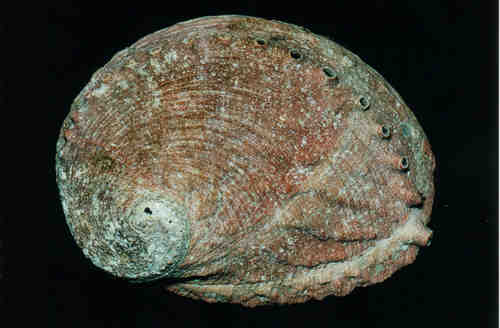
Haliotis rubra Leach, 1814 Shark Island, Sydney Harbour, 140 mm
H.coccoradiata is a much smaller species than H.rubra, and it can be collected live at low tide. The smaller picture
below shows close up detail of the surface sculpture. The colour and pattern are highly variable as can be seen in the larger photograph with seven specimens. All shells were all dead collected at Kurnell, NSW. There are 6 or 7 open holes and many closed holes. This species most closely resembles
H.rubra, but it only grows to a length of 50mm. Also found in Victoria.
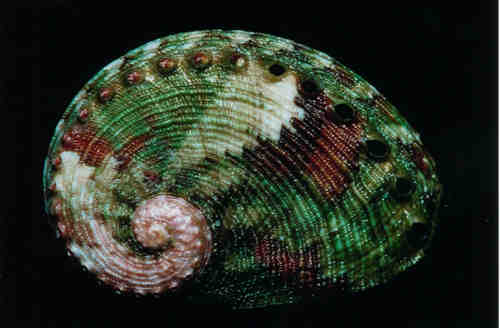
Haliotis coccoradiata Reeve, 1846, Kurnell, NSW
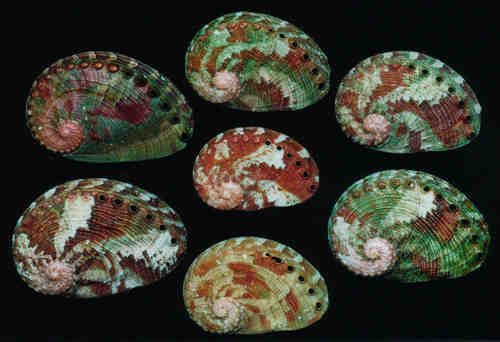
Haliotis coccoradiata Reeve, 1846, Kurnell, NSW
H.brazieri is another small species which grows to a length of 50mm. The eroded specimen, top right, is perhaps the largest on record, being 50mm. It was found at a depth of 13m in Sydney Harbour, NSW. The photograph below it shows a better specimen, found dead at 11m in Sydney Harbour. The colour is typically red and green and there are fewer holes than the previous two species. The holes are also quite raised.
H.brazieri is very difficult to find, since it is only found at depths greater than 13m and in very calm conditions. The surface is also usually very well camouflaged with encrusting growths which makes its detection difficult. Usually found under small rocks.
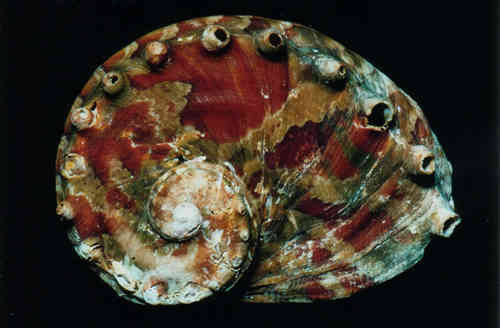
Haliotis brazieri, Angas, 1869 Sydney Harbour, 50 mm
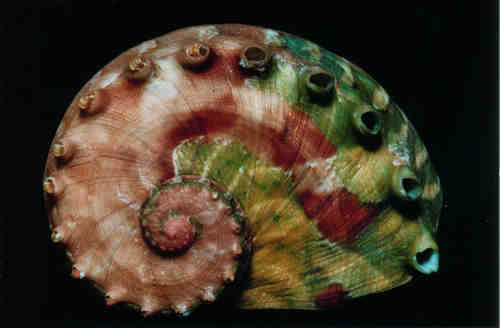
Haliotis brazieri, Angas, 1869 Sydney Harbour
H.hargravesi is very similar to H.brazieri, and indeed there are examples which show intermediate characteristics for both. (Middle photograph of three to the right). It grows to a length of 47mm. Once again, a fresh dead specimen of this size was found in Sydney Harbour at a depth of 16m at the base of a rock cliff, and it is probably the largest specimen known. (Photograph to the right). This species has 4 deeply incised ridges, but the number of ridges is variable. The middle photograph of the three also from Sydney Harbour, dead at 12m shows only two ridges, and the bottom photograph, which incredibly was found on the beach at Fingal Bay, NSW has 6 ridges. This specimen is also the smallest, being only 27mm long. H.hargravesi
inhabits the same type of environment as H.brazieri. It is a subtidal species, that is never common. This is partly due to the lack of a suitable habitat at depths greater than 15m, where there are very few small rocks and most of the sea floor is muddy sediment, especially in Sydney Harbour.
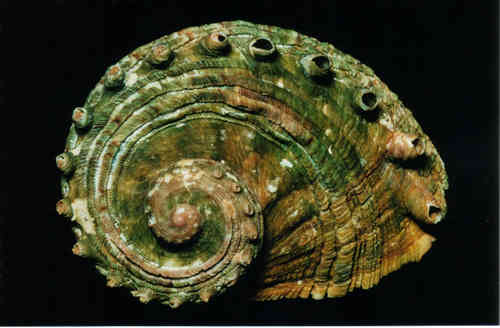
Haliotis hargravesi, Cox, 1869 Sydney Harbour, 47 mm
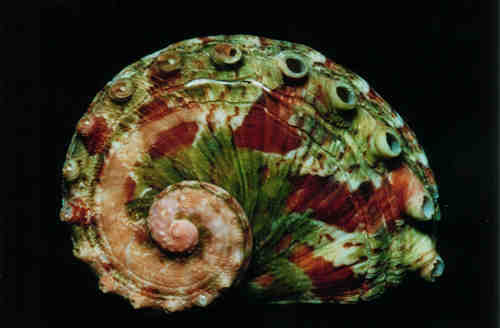
Haliotis hargravesi/brazieri, cross-breed, Sydney Harbour
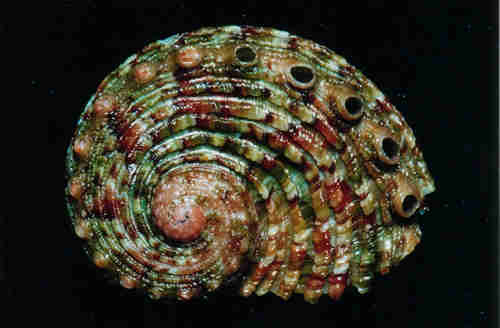
Haliotis hargravesi, Cox, 1869, Fingal Bay NSW, 27 mm
Shell Club Minutes 28/07/2001.
The meeting was opened by P. Jansen at 2:00pm. Apologies were received from: N. & M. Anderson, K. & F. McCamley.
Field Trip Reports:
Steve Dean reported on a collecting trip to Thailand. He visited the Som Nuk Shell Museum at Phuket. The museum is underground and has shops above it. There is a very good fossil display with everything in perspex bubbles for protection. At present it is a professional museum, with plans to create a research area for people to get hands on experience with the shells.
1200 trawlers supply shells to the museum owners and many are rare and unusual. The more common shells are exported or sold in the shops. Shells are no longer imported from the Philippines as the local quantity and quality of shells is sufficient. Steve witnessed an unusual display of boulder oysters is being prepared for another museum. Cleaning shells is easy in Thailand as there are tiny flies which lays their eggs in the rotting shells and the maggots clean them out.
Container loads of shells wash up on some beaches. Muddy coral flat areas yield cowries, eels and stonefish.
Patong is a tourist area good for cowries and very dark nerites. The locals eat the nerites and bivalves. Cost of trip is fairly cheap with air fares around $1000 including accommodation and breakfast.
New Books:
M. Keats mentioned Alison Haynes' new book "Freshwater Snails of the Tropical Pacific Islands" was available.
P. Jansen showed the "Review of Recent Mediterranean and North Eastern Atlantic Species of Muricidae" by Roland Houart and the "Monograph of the Living Zoila" by Felix Lorenz.
General Business:
John Franklin gave us an update of the club's financial position.
John Franklin agreed to be the extra NSW Branch representative to the MSA National E-Council.
Chris Barnes tabled the information regarding the 4th New Zealand Shell Show., to be held in Wellington, January 26th - 27th 2002.
Meeting closed at 3.38pm
C. & K. Barnes Secretary
Shell Club Minutes 25/08/2001.
The meeting was opened by P. Jansen at 1:55pm.
Field Trip Reports:
Maureen & Noel Anderson attended the Yeppoon and Townsville Shell Shows. Ron Moylan attended the Yeppoon show. and John Dunkerley the Townsville show. Maureen reported that the shows had lots of food available and constant raffles. Tables at the Townsville show were decorated with tea towels depicting marine motifs. A Cake, Arts and Crafts Stall was set up to help make money for the club. The Keppel Bay club has it's own clubhouse on its own land. The Shell Show dinner on the Saturday night was great with good food and company. The Shell of the Show was a Strombus triformis which was unfortunately dropped and broken whilst being photographed. The locals were very friendly and made Noel & Maureen very welcome.
New Books:
Two segments of the "Iconography" series are coming out. Volutidae Parts 1&2 contains mostly Australian species and were co written by Allan Limpus.
P. Jansen presented "1001 Nudibranchs", the new offering from Neville Coleman and "Orchids of the Philippines" by occasional club visitor, Jim Cootes.
General Business:
Tea and Coffee charges are still under discussion with Cheryl Sutton from RELC. Chris Barnes is continuing to follow up on this matter.
Ron Moylan discussed the amended list of categories for the club shell show in October which will be published in the next "Sheller".
Presentation:
Chris Barnes presented a slide show as a follow up to his article "Cypraea of Little Bay 2001".
Meeting closed at 3.38pm
C. & K. Barnes Secretary
Shell Club Minutes 22/09/2001.
The meeting was opened by Maureen Anderson at 2.00 pm.
Field Trip Reports:
Chris Barnes talked about his recent trip to Yamba and Iluka, Northern Rivers NSW. Chris added he and Karen were able to catch up with David Tarrant and family on the way north to glean some local knowledge. Chris passed around specimens of Cypraea arabica, isabella, fimbriata, ziczac, kieneri, gracilis, humphreysii, carneola, asellus, cernica, subviridis, xanthodon and clandestina. Unfortunately a Cypraea hammondae Iredale, 1939 was not to be found. Other species of interest collected included Vexilla vexillum (Gmelin 1791), Cronia contracta (Reeve, 1846), Nassarius conoidalis (Deshayes, 1832), Nerita polita Linnaeus, 1758, Conus coronatus Gmelin, 1791.
John Franklin reported on a trip to Fiji where he acquired specimens of Cypraeidae and Strombidae.
New Books:
Neville Coleman has very generously donated an autographed copy of his book "1001 Nudibranchs" to the club.
General Business:
Tea and Coffee charges have still not been resolved. All the information has been handed over to John Franklin so he can liaise with Cheryl Sutton and chase credits where the club has been incorrectly charged.
Presentation:
Members were asked to bring a favourite shell to the meeting. C. Barnes showed a recently collected Cypraea fimbriata Gmelin, 1791 and Peter Pinnear displayed some Cymbiola pulchra complex
Meeting closed at 2.45pm
C. & K. Barnes Secretary
Swains and the Coral Sea
By Steve Dean
Last year I wrote an article for the Sheller about a shell-collecting trip I did in the Swains Reefs with a number of other shell collecting enthusiasts. The trip was organised by Doug Thorn on his boat "The Australiana" out of Gladstone QLD. Well, this year's trip was in September. Most of the same collectors went including myself. There were two new international participants, Mike from South Africa and Mike the Canadian Ambassador to Cuba. Since Mike Hart from New Zealand came again, this created some confusion.
The collecting process was the same as last year, dredging, snorkelling, diving day and night, and reef walking. The only difference was the addition of a fifth dingy so that all methods of collecting could be undertaken at the same time.
To keep this article brief, refer to my last years article for details of how each type of collecting is done.
This year's trip had a lot of extra fuel on board, as the intention was to go straight through the Swains Part of the Great Barrier Reef continuing NNE into the Coral Sea to Marion Reef.
Marion Reef is on the top of the rim of a volcanic crater. Rising from the Coral Sea floor, it is well outside Australian Continental Shelf. The crater rim is 30 km diameter and is fully submerged. Around its Eastern half a coral reef has reached the surface, making a 50 km half moon reef. At low tide there are sand bars along much of this reef, but only a few "sand islands" with no plants remain at high tide. Much of this half moon reef has shallow areas along the inside of the crater, while rapidly dropping thousands of feet on the outside. The Western rim of the crater is primarily deeper 150 m + with the occasional reef pinnacle reaching the surface. There are many small reefs reaching the surface or creating shallow areas within the crater, and they are not well charted.
To get to Marion we had an overnight voyage from Gladstone Harbour to the inside edge of the Swains, one day to cross the Swains part of the Barrier Reef, actually takes half a day so we stopped at two reefs to collect and fill in time, then another overnight voyage arriving at the bottom of Marion Reefs during the daylight.
During these trips Doug tries to plan the itinerary so that we may find things that are rare. During the crossing of the Swains we went looking for
Cymbiolacca excelsior a very rare volute, of which only four had ever been found before. We found a couple, and voted to stay an extra day, before proceeding Marion. See picture front cover. We found more
Cymbiolacca excelsior, but many we observed were only juvenile. The lagoon where they were was full of stag horn coral bommies, with limited sand areas.
Last year's trip was predominantly calm weather. This year much of the time the wind was 25 to 30 Knots. The wind and waves reduced the times and methods of collecting.
Marion was an exploratory trip and there were signs of all of the rarer shells we expected, but the reef was too large and time too short for us to find good collecting sites. We only collected at two locations and these were 15 km apart. We had to cut short the days at Marion because of the worsening weather.
We went back to the Swains and even then had to select reefs with fully enclosed lagoons for shelter. (Perfect Lagoon and Heralds Prong)
Within Perfect Lagoon there were strong currents due to the amount of water washing in over the reef due to waves. As a result much of the diving was only at low tide and from the main boat.
At Heralds Prong there was nearly a full day where the wind was too strong and the wave chop too high to allow effective safe dredging. Again diving was primarily near the main boat mid-lagoon, Getting back on board at the end of each dive was an effort. The snorkellers were complaining of feeling seasick. I know I did not want to swim along the surface for any distance.
There were more day dives than last trip, partly because with the currents and the wind diver retrieval was a concern.
In spite of the poorer conditions I did not get seasick, - unlike last trip.
Never the less, the weather did not stop us collecting and a good variety of shells were obtained. Last year all the rarer shells were divided into equal lots at the end of the trip and we each drew a number to get our equal shares. The common shells were just placed on a table each day and those that wanted them took what they needed, the remainder being released before they died.
This year was slightly different. Common shells brought in that no one wanted were released. However for any common species, once enough were collected all collectors were advised not to bring any more back to the boat. Then every last shell on board was kept in the common pool and divided into lots for equal distribution after the trip. This applied to absolutely everything common, rare, live or dead taken.
Last year shells were place in a metho/salt water solution and many were cleaned on board. This year all shells were placed in bags in the deep freeze and none were cleaned. After the divide up back at Doug's house most collectors kept their shells still frozen for air travel. Most of mine are still frozen, waiting to be cleaned.
Marion was supposed to have a selection or rare shells. We found signs of all of them but never found their actual habitats and locations. Giant
Conus flocatus - only one good one, one poor one and three broken pieces found. Albino Harpidae - one dead worn one found.
Strombus vomer vomer - one live one and one well dead one found.
Strombus thersites some barely recognisable very worn ones with hermit crabs while reef walking.
At Marion we contented ourselves with Strombus haemostoma, Strombus
dentatus, and the less common Strombus wilsoni. I also liked the dwarf form of
Lambis chiragra. It is apparently also found at East Diamond Islet. (East Diamond is a 3/4 day sail WNW back towards Townsville from Marion).
There were few shells on the reef intertidally at Marion, probably because of the exposed open ocean location, only the toughest shells could hang on without being washed into deeper water. For the same reason fragile corals including stag horn were limited on the intertidal reef areas. There were however some Cypraedae, Conus, very large Vasum and a selection of Morula and Drupa species, and some
Lambis truncata.
For those of us that also collect bivalves there were very few bivalves brought up in the dredges at any of the reefs we visited, but I did get a few nice specimens, and a couple of species I did not have.
|









